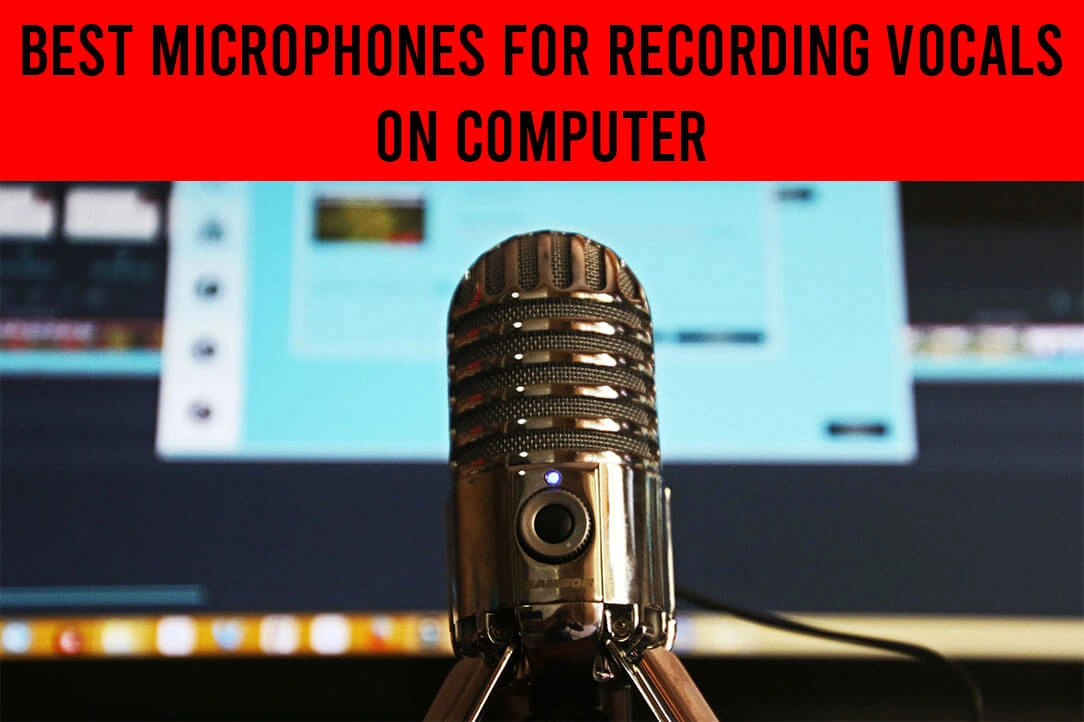Best Microphones for Recording Vocals on Computer

Best Microphones for Recording Vocals on Computer 1
This post may contain affiliate links, which means we may earn a commission if you make a purchase. As an Amazon Associate we earn from qualifying purchases. Thank you for your support!
Recording vocals on a computer has become increasingly popular in recent years, whether you are a professional musician or a podcaster. However, to achieve high-quality sound, choosing the right microphone is crucial. With so many options on the market, it can be overwhelming to determine which microphone is best suited for your needs.
The right microphone can make all the difference in the clarity, warmth, and overall quality of your recordings. There are a few key factors to consider when choosing a microphone, such as polar pattern, frequency response, sensitivity, connectivity, and room acoustics. Additionally, having the right accessories, such as pop filters and shock mounts, can further improve the quality of your recordings.
In this article, we will provide an overview of the best microphones for recording vocals on a computer. We will also discuss the essential features to consider when purchasing a microphone and provide a buying guide to help you make an informed decision. Whether you are a beginner or an experienced recording artist, this guide will help you choose the best microphone for your needs and budget.
Top Picks for High-Quality Vocal Recording with a Computer (5 Best Microphones)
Audio-Technica AT2020
Audio Technica At2020
The Audio-Technica AT2020 is a popular choice for home and project studio applications, and for good reason. It’s known as the price/performance standard inside studio condenser microphone technology.
One of the standout features of the AT2020 is its custom-engineered low-mass diaphragm, which provides extended frequency response and superior transient response. It also has a high SPL handling capability and a wide dynamic range, making it a versatile choice for recording vocals, acoustic instruments, and percussion.
The AT2020 has a cardioid polar pattern, which helps to reduce the pickup of sounds from the sides and rear, improving the isolation of the desired sound source. It also has an integral 3-pin XLRM-type output connector.
The noise level of the AT2020 is 20 dB SPL, which is relatively low, and it’s a good choice for recording in a home studio environment.
All in all, the Audio-Technica AT2020 is an excellent choice for those looking for a high-quality microphone for their home or project studio setup. Its affordable price, coupled with its exceptional performance, makes it a great value for money.
Pros of Audio-Technica AT2020:
Excellent sound quality
Versatility for various recording applications
Durable build quality
Affordable price
Cons of Audio-Technica AT2020:
Requires phantom power
Sensitive to handling noise
Limited polar pattern
Lacks built-in accessories
Requires external mounting
Rode Podcaster
Rode Podcaster
The Rode Podcaster is a dynamic microphone that connects to your computer via USB. It’s designed specifically for podcasting, but it’s also an excellent choice for recording vocals on a computer.
One standout feature of the podcaster is its on-air indicator LED, which lets you know when the microphone is active and when it’s muted. It also has an ultra-low noise floor, which means it’s excellent at rejecting unwanted background noise.
The podcaster has a cardioid polar pattern, which provides high 180-degree rejection, helping to isolate the sound source and reducing the pickup of unwanted ambient noise. Additionally, it features an internal pop filter, which helps to minimize plosives and other unwanted sounds that can be produced when recording vocals.
If you’re looking for a microphone that’s specifically designed for podcasting or vocal recording on a computer, the Rode Podcaster is an excellent choice. Its dynamic microphone with USB connection, on-air indicator LED, ultra-low noise, cardioid polar pattern, and internal pop filter make it a standout option in its class.
Pros of Rode Podcaster:
Excellent sound quality
USB connectivity for easy plug-and-play setup
Integrated pop filter for clear audio recordings
Durable build quality
Cons of Rode Podcaster:
Limited versatility for other recording applications
USB-only connectivity may not be compatible with all devices
No XLR output for traditional audio interfaces
Higher price compared to some other USB microphones
Requires monitoring for optimal recording levels
Samson Q2U
Samson Q2u
Moving on with our third recommendation, we have the Samson Q2U. It is a unique microphone that offers the best of both worlds. It’s a professional handheld dynamic microphone that has both USB digital output for connecting to a computer and an XLR analog output for connecting to a mixer, audio interface, or portable PA system.
Also, it has a dynamic microphone capsule with a cardioid pickup pattern that captures sound from in front of the microphone while minimizing ambient sounds and other room noises. This feature makes it an excellent choice for podcasting, home recording, or voiceover work. Additionally, it helps to reduce possible feedback in live performance settings.
The onboard 1/8″ (3.5mm) headphone jack allows for zero-latency monitoring, so you can hear yourself without any delay or echo, plus a mix of your computer’s audio playback. It also features a solid, die-cast construction with a heavy gauge mesh grille, making it a durable option.
One good thing about the Q2U is that it is a plug-and-play device, meaning it doesn’t need any special drivers to work with your computer. Just connect the microphone to your computer, launch your favorite audio software, and start recording. The Q2U Recording and Podcasting Pack include everything you need to start recording great-sounding projects, including an extended desktop stand with a mic clip, a pop filter for reducing pops, and USB and XLR cables.
It is an excellent choice for those who want a versatile microphone that can handle multiple recording situations. Its professional handheld dynamic microphone with USB digital output and XLR analog output, cardioid pickup pattern, zero-latency monitoring, and included accessories make it a top contender in its class.
Pros of Samson Q2U:
Dual connectivity (USB and XLR) for versatility.
Excellent sound quality with wide frequency response.
Durable build quality for regular use.
Complete recording kit with included accessories.
Cons of Samson Q2U:
Sensitivity to handling noise
Limited polar pattern options (cardioid only)
USB connectivity limitations
Basic included accessories
No built-in monitoring capabilities
HyperX QuadCast
Hyperx Quadcast
HyperX QuadCast is a great option for streamers looking for a standalone condenser microphone. With four polar patterns to choose from, it offers excellent versatility for different recording situations. The conveniently located gain control and headphone jack allow for easy monitoring of sound and mic input levels. Its frequency response of 20Hz – 20kHz provides faithful sound reproduction.
The microphone stands and adapter that comes with the QuadCast offer a sturdy and reliable setup for recording. Additionally, its compatibility with both PC and Mac computers, as well as the PS4, makes it a versatile option for gamers and streamers.
The USB plug-and-play connectivity feature is also a bonus, making it simple to set up without the need for additional drivers. Overall, the HyperX QuadCast is a solid choice for those looking for a high-quality standalone condenser microphone for streaming and gaming purposes.
Pros of HyperX QuadCast:
Outstanding sound quality with selectable polar patterns
Easy to use with intuitive controls
Stylish and durable design with built-in shock mount
Versatile mounting options with included desktop stand and threaded mount
Built-in anti-vibration shock mount for clean recordings
Cons of HyperX QuadCast:
USB connectivity only
Sensitive to plosive sounds
Higher price range
Non-removable USB cable
Shure SM57
Shure Sm57
The Shure SM57 is one of the most popular dynamic microphones in the world for a good reason. It’s an excellent workhorse microphone that can handle almost any instrument or sound source.
It is particularly suited for close miking of instrument amps and speakers, making it an excellent choice for guitarists and other instrumentalists. The microphone also features a natural presence peak that brings out extra clarity in vocals and many instruments. With its tight cardioid polar pattern, the SM57 provides excellent gain before feedback, and its durable construction ensures that it can withstand even the toughest conditions, wear, and abuse.
The Shure SM57 is a versatile and reliable dynamic microphone that has become an industry standard. It is an excellent choice for both live performances and studio recording, as it can capture the sound of virtually any instrument or sound source with its natural presence peak and tight cardioid polar pattern. Its durable construction and ability to withstand harsh conditions and abuse make it a go-to choice for musicians on the road.
Pros of Shure SM57:
Legendary sound quality.
Durable and reliable.
Versatile applications.
Iconic design.
Value for money
Cons of Shure SM57:
Limited polar pattern
Requires external equipment
Lacks built-in features
Lower sensitivity
Limited frequency response
Conclusion
In summary, the best microphones for recording vocals on a computer are the ones that deliver high-quality sound, eliminate unwanted noise, and work seamlessly with your recording software. Some of the top picks include the Audio-Technica AT2020, Rode Podcaster, Samson Q2U, HyperX QuadCast, and Shure SM57.
When choosing a microphone, consider the polar pattern, frequency response, sensitivity, connectivity, pop filter, shock mount, and room acoustics. Additionally, be mindful of your budget and make sure the microphone you choose meets your needs without breaking the bank.
Key considerations when choosing a microphone include your intended use, your recording environment, and your personal preferences for sound quality.
Overall, the best microphone for recording vocals on a computer will depend on your individual needs and preferences. However, by following this guide and considering the factors mentioned above, you should be able to make an informed decision and find a microphone that will help you achieve the best possible recording quality.
Like this project
Posted May 12, 2023
Looking for the best microphones for recording vocals on your computer? Look no further than our comprehensive guide.
Likes
0
Views
17






